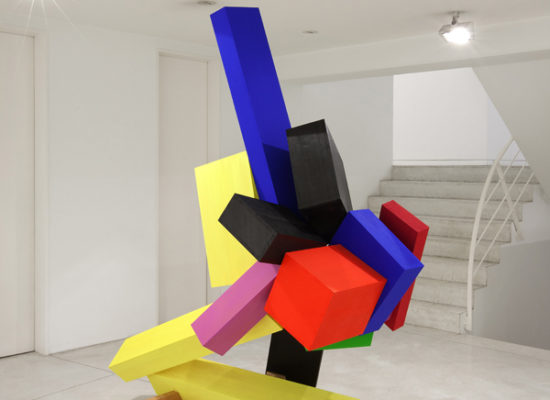It’s an exhibition well worth a place within any museum. That’s not only because Galerie Karsten Greve’s current retrospective of American sculptor Joel Shapiro provides an excellent overview of the artist’s oeuvre from the last 15 years but also due to the show’s prime contribution to current discussions around abstraction’s relevance to contemporary art, an artistic mode that has for quite some time seen a resurgent, keen interest among younger artists.
Shapiro may belong to a generation who can look back on 40 years of artistic creation, but his recent work surprises with the freshness and joy with which it plays with form, color, balance, and associations more often attributed to artists far his junior. And although he arose from constructivism and was influenced by the strict principles of form developed by the minimalists, Shapiro has always eluded strict association with or adherence to the movements’ principles. The works may be constructed of individual pieces, and thus sit within a constructivist tradition, but not purely so. They’re also not purely minimalist works. For, while the minimalists shunned content of any kind, Shapiro deliberately brings content to the fore.
Central to the Cologne gallery’s exhibition is Shapiro’s large-scale sculpture, Ghost (2003–2005). Poised on three stainless steel discs, a construct made of painted wood blocks resembles a spiraling behemoth, whereby the tension between the disparate pieces evokes actual hawkishness. Through its disproportionate size, instability, and clumsiness of form, the construction looks slightly ridiculous. And it really is. It’s full of Shapiro’s characteristic quiet humor, which extends classical definitions of minimalism and constructivism to a wider range of associative elements.
Innuendo and humor are also to be found in other works on view across Greve’s rooms. Most of the sculptures have been left untitled. But even as such, the works’ twisted constructions, precariously balanced and lifted by their glowing colors, are truly memorable. Subliminally, humor always arises when looking at Shapiro’s work. Even if the carefully balanced wooden beams—as they first appear—are actually cast in bronze, his humor makes each unique. Likewise, for the small floor sculptures made of plaster. The oldest of the group of works on show is from 1980. Others were created as recently as 2014. They evoke a small house about to tilt over, a warehouse, or a cube connected to another cube, like in a Frank Gehry museum model. But the associations are purely incidental. One could choose to focus purely on form. In their characteristic wittiness, ambiguity, and humor, Shapiro’s works depart from the strict principles of minimalism. And this, in turn, renders them singular and particularly relevant.
Joel Shapiro, “Wood, Plaster, Bronze” is on view at Galerie Karsten Greve Cologne through April 11, 2015.
